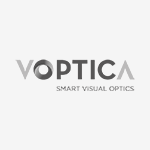Purpose: Although adaptive optics (AO) is well established as a powerful experimental tool for vision research, its use in the clinic is still in an early stage. Since those instruments combine optical measurements and visual testing, optimized wavefront guided refraction is made possible. We have evaluated in a clinical environment the performance of a new commercially available instrument based on AO and compared it to the current standards of measuring.
Methods: The AOnEye (VOPTICA SL, Murcia, Spain) was used to measure a population of 48 eyes (24 subjects: 30.5±4.3 years, refraction:-1.68±1.64D). The instrument incorporates a Hartmann-Shack wavefront sensor to measure the ocular aberrations and the objective refraction (Obj Rx). A spatial light modulator controls the eye’s optics and a micro-display presents visual stimuli to the patient. This allows the operator to make refinements of the Obj Rx from the feedback of the patient’s visual experience. The repeatability was calculated for the measured aberrations, the subjective (guided) refraction (Subj Rx) and the uncorrected (UC) and best corrected (BC) visual acuity (VA). Further the mean spherical equivalent (M), both cross cylinders (J0 and J45) as well as the UCVA and BCVA were compared to the current clinical standards (phoropter) using a one-way paired t-test. Also the correlation and the slope of the regression curve were calculated.
Results: The Subj Rx as well as the VA measured with the AOnEye was not significant different from the results of the phoropter: p = 0.79, 0.1, 0.61, 0.41 and 0.20, respectively for M, J0, J45, UCVA and BCVA. For the same order of parameters the Pearson correlation coefficient and the slope were: 0.98/0.89, 0.87/0.95, 0.84/0.89, 0.95/1.00 and 0.68/0.36. The low correlation of the BCVA is due to a saturation effect where the maximum VA achievable with the phoropter was -0.15 logMar while for AOnEye was -0.20 logMar. The two standard deviation repeatability for the AOnEye’s wavefront sensor was 0.30 D, 0.09 D, 0.10 D, 0.05 µm for respectively M, J0, J45 and the mean of the aberrations calculated for a 4.5 mm pupil. The repeatability for UCVA and BCVA was respectively 0.06 and 0.04 LogMar.
Conclusions: The use of adaptive optics guided refraction assures accurate and repeatable results in most patients but providing more versatility. On average, refraction and VA results using the AOnEye provided similar results as the current phoropter-based standards.
Methods: The AOnEye (VOPTICA SL, Murcia, Spain) was used to measure a population of 48 eyes (24 subjects: 30.5±4.3 years, refraction:-1.68±1.64D). The instrument incorporates a Hartmann-Shack wavefront sensor to measure the ocular aberrations and the objective refraction (Obj Rx). A spatial light modulator controls the eye’s optics and a micro-display presents visual stimuli to the patient. This allows the operator to make refinements of the Obj Rx from the feedback of the patient’s visual experience. The repeatability was calculated for the measured aberrations, the subjective (guided) refraction (Subj Rx) and the uncorrected (UC) and best corrected (BC) visual acuity (VA). Further the mean spherical equivalent (M), both cross cylinders (J0 and J45) as well as the UCVA and BCVA were compared to the current clinical standards (phoropter) using a one-way paired t-test. Also the correlation and the slope of the regression curve were calculated.
Results: The Subj Rx as well as the VA measured with the AOnEye was not significant different from the results of the phoropter: p = 0.79, 0.1, 0.61, 0.41 and 0.20, respectively for M, J0, J45, UCVA and BCVA. For the same order of parameters the Pearson correlation coefficient and the slope were: 0.98/0.89, 0.87/0.95, 0.84/0.89, 0.95/1.00 and 0.68/0.36. The low correlation of the BCVA is due to a saturation effect where the maximum VA achievable with the phoropter was -0.15 logMar while for AOnEye was -0.20 logMar. The two standard deviation repeatability for the AOnEye’s wavefront sensor was 0.30 D, 0.09 D, 0.10 D, 0.05 µm for respectively M, J0, J45 and the mean of the aberrations calculated for a 4.5 mm pupil. The repeatability for UCVA and BCVA was respectively 0.06 and 0.04 LogMar.
Conclusions: The use of adaptive optics guided refraction assures accurate and repeatable results in most patients but providing more versatility. On average, refraction and VA results using the AOnEye provided similar results as the current phoropter-based standards.


